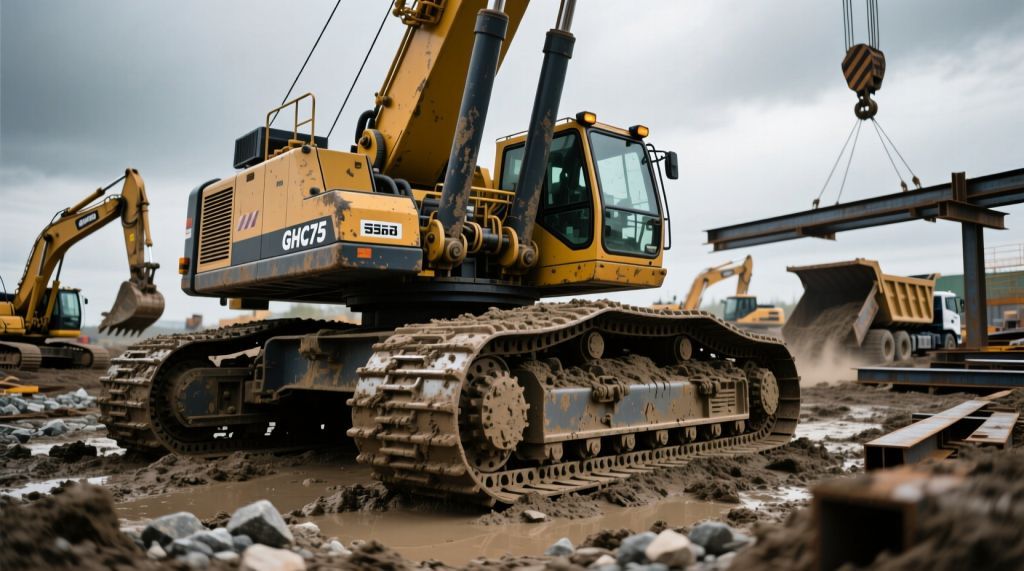
The Grove GHC75 is a workhorse, designed to excel in challenging environments like muddy fields, rocky slopes, or uneven construction sites. Its undercarriage is the key to this resilience, providing the traction and stability needed for heavy lifts and smooth movement. However, the undercarriage endures constant stress, wearing faster than other components and requiring careful attention to avoid costly downtime.
By understanding how to monitor wear and source reliable Grove crane parts, operators can keep the GHC75 running smoothly. This guide offers practical steps for undercarriage maintenance, keeping things clear and actionable.
The Undercarriage’s Vital Role
The undercarriage is the heart of the Grove GHC75’s mobility and stability. It supports the crane’s weight, absorbs shocks from rough surfaces, and ensures steady movement across challenging terrains. Components like track chains, rollers, idlers, sprockets, and track shoes work together to maintain performance. When one part fails, it strains the entire system, turning minor issues into major expenses.
Where Wear Begins
Undercarriage wear develops gradually from constant use. Each turn, reversal, or pass over debris erodes components. The GHC75’s steel tracks are built to last, but abrasive materials like mud, gravel, or sand accelerate wear. Uneven terrain often stresses one side of the tracks more, creating uneven wear that can worsen if ignored.
Operators can’t eliminate wear, but they can stay proactive. Learning to spot early damage helps prevent small problems from becoming major failures.
Track Chains and Shoes: Critical Wear Points
Track chains are prone to early wear due to constant stress. The pins and bushings linking the chain segments endure relentless force, stretching over time. This causes sagging, which disrupts track tension and can damage rollers or sprockets. When adjustments can’t restore proper tension, replacing the chain with genuine Grove crane parts is necessary.
Track shoes, the steel plates bolted to the chains, face direct ground contact. Abrasion thins them, reducing traction and stability. Worn shoes may flex excessively under load, affecting the crane’s balance. Replacing them early prevents further strain on the undercarriage.
Rollers and Idlers: Supporting the Load
Rollers and idlers guide the track chain and distribute weight across the ground. Bottom rollers carry the crane’s load, while top rollers support the track’s return path. Both face significant impact. A roller that stops rotating smoothly drags the track, causing friction and heat, often accompanied by squeaks or visible wear marks.
Leaking seals around rollers signal bearing wear, which can lead to seizing if ignored. Idlers, which control track tension, wear at their flanges, causing uneven pull that stresses chains and sprockets. Routine checks can catch these problems before they escalate.
Sprockets: Powering Movement
Sprockets drive the track chains, meshing with bushings to propel the crane. Worn sprocket teeth become sharp or hooked, losing traction and causing the chain to skip or ride unevenly. This accelerates wear across the undercarriage. Replacing sprockets and chains together, sourced from a reputable crane parts supplier, ensures compatibility and longevity.
Track Tension: A Key Factor
Track tension is critical for undercarriage performance. Overly tight tracks increase friction, wearing components faster, while loose tracks cause slapping or skipping, leading to similar damage. The GHC75’s tracks should have a slight sag for optimal performance. In wet or muddy conditions, debris buildup can alter tension, requiring frequent checks.
Releasing tension after shifts in damp environments prevents rust and reduces stress on the adjuster, prolonging component life.
Early Warning Signs
Undercarriage problems often start subtly—a slight squeak, uneven movement, or small leaks around rollers. Uneven track wear or pulling to one side suggests misalignment or component wear. Ignoring these signs risks catastrophic failure, leading to downtime and costly repairs.
Regular inspections are cost-effective. Catching a worn roller or stretched chain early allows for targeted replacements, avoiding a full undercarriage overhaul.
Choosing Quality Parts
When replacements are needed, partnering with a trusted crane parts supplier is essential. The GHC75’s undercarriage requires precision components, and genuine Grove crane parts or OEM-quality equivalents ensure proper fit and durability. A reliable supplier can match parts to your crane’s specifications, using its serial number and operating history.
Generic or low-quality parts may fit but often fail quickly, disrupting the undercarriage’s balance and risking warranty issues. A reputable crane parts supplier prioritizes quality, saving costs in the long run.
Maximizing Undercarriage Longevity
While wear is unavoidable, proactive maintenance can slow it down. Cleaning tracks after shifts removes abrasive debris that erodes components. Avoiding sharp turns or spinning tracks on hard surfaces reduces stress on chains and sprockets. For idle cranes, periodic movement prevents corrosion.
Consistent greasing of rollers and idlers maintains seal and bearing health, keeping dirt out. A disciplined maintenance routine extends undercarriage life significantly.
Conclusion
The Grove GHC75’s undercarriage is its toughest component, enabling it to handle demanding terrains while supporting heavy lifts. Its reliability hinges on regular maintenance and timely replacements. By monitoring wear and acting promptly, operators can avoid breakdowns and keep the crane productive.
When sourcing parts, rely on a trusted crane parts supplier for genuine Grove crane parts. Quality components ensure the undercarriage performs as designed, minimizing downtime and maximizing efficiency. With proper care, the GHC75’s undercarriage will keep the crane ready for any challenge.